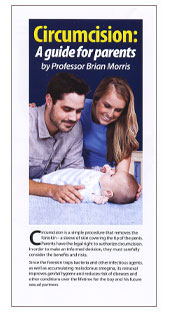Circumcision - Inflammatory Dermatoses
Systematic Review:
For a systematic review in the International Journal of Preventive Medicine see: [Morris & Krieger, 2017].
Balanitis and posthitis:
To paediatric surgeons, the most obvious medical reasons for circumcision are balanitis (inflammation of the glans) and posthitis (inflammation of the foreskin). Both are very painful conditions.
Posthitis is limited to uncircumcised males. Balanitis is seen in 11-13% of uncircumcised men, but in only 2% of those who are circumcised [Fakjian et al., 1990; Kohn et al., 1999]. In uncircumcised diabetic men it is 35% [Kohn et al., 1999].
In boys the incidence of balanitis is twice as high in those who are uncircumcised [Herzog & Alvarez, 1986; Fergusson et al., 1988]. In babies, balanitis is caused by soiled diapers, playing and sitting in dirty areas, antibiotic therapy, as well as yeast and other micro-organisms. Balanitis caused by the group A haemolytic variety of Streptococcus is present exclusively in uncircumcised boys [Orden et al., 1996]. In children, balanoposthitis is most common between age 2 to 5 [Escala & Rickwood, 1989]. About 4% of uncircumcised boys get it [Escala & Rickwood, 1989].
In balanoposthitis the entire front end of the penis becomes red, painful and swollen, often accompanied by a smelly discharge of pus [Schoen, 2007d]. It tends to be associated with phimosis and inability to clean under the foreskin of young boys because the foreskin is still lightly attached to the penis beneath it [Schoen, 2007d].
Balanitis is a cause of phimosis, as discussed in the section on Physical Problems. Pathological phimosis can arise from secondary cicatrization of the foreskin orifice due to balanitis xerotica obliterans (BXO). Once thought to be rare, and a disorder presenting in adulthood, BXO is now regarded as common in young boys, in whom treatment by circumcision is advocated to prevent the complications that occur later in life [Yardley et al., 2007]. Thus whereas a rate of 1% has been reported [Rickwood et al., 2000], others find an incidence in the UK of 5-6% in uncircumcised boys under 18 and under 15, respectively [Griffiths & Frank, 1992; Huntley et al., 2003].
A study in Plymouth found BXO in 35% of the 80% of boys aged 3 months to 16 years (mean 6) who had been circumcised following foreskin problems [Yardley et al., 2007]. Histological abnormalities were seen in 85% of those circumcised, chronic inflammation in 47%, and fibrosis in 3% [Yardley et al., 2007]. In this study, overall BXO frequency in the boys referred was 12%. Similarly, a prospective study involving 1,178 boys in Budapest who presented consecutively over the decade 1991-2001 and were then treated by circumcision found by histological examination that BXO incidence was 40%, peaking at age 9-11 (76%), BXO being the cause of the secondary phimosis in all of these [Kiss et al., 2005]. In the study as a whole, 19% of boys had early, 60% intermediate and 21% late form of BXO.
The narrow foreskin opening causes urinary obstruction that can be partial or complete. As well as urethral stenosis, meatal stenosis is seen, making it a significant condition [Yardley et al., 2007]. Indeed, BXO is generally regarded as an indication for circumcision [Yardley et al., 2007]. In one series in Boston of pediatric BXO, amongst 41 patients, 52% had been referred for phimosis, 13% for balanitis and 10% for buried penis [Gargollo et al., 2005]. Of these, 46% underwent curative circumcision, 27% also had BXO involvement of the meatus and had not only circumcision, but meatotomy or meatoplasty, and 22% required extensive plastic surgery of the penis, including buccal mucosa grafts, demonstrating a more severe and morbid clinical course.
The incidence of yeast fungi was 44% in uncircumcised boys and 18% in circumcised boys (ages 8 months to 18 years; men 6.4 years), i.e., was 2.4 times higher in the uncircumcised [Iskit et al., 2006]. The yeast species found were, in order of frequency, Malassezia globosa, M. furfur, M. slooffiae, Candida albicans, C. tropicalis, C. parapsilosis. All were present in uncircumcised infants (age <1 year), but none in circumcised. A gradual accumulation then occurred in a portion of the circumcised boys with age so that by age 18 yeast were found in 62.5% of uncircumcised and 37.5% of circumcised boys.
Penile skin diseases also include psoriasis, those arising from penile infections, lichen sclerosis, lichen planus, schorrheic dermatitis, and Zoon balanitis. The various conditions have been reviewed extensively [English et al., 1997; Kohn et al., 1999; Singh & Bunker, 2008] and are either much more common in, or totally confined to, uncircumcised males. For example, all patients with plasma cell (Zoon) balanitis, bowenoid papulosis, and non-specific balanoposthitis were uncircumcised [Mallon et al., 2000]. Mycobacterium smegmatis has been implicated in Zoon balanitis [English et al., 1997]. Typical symptoms of Zoon balanitis include erythrema (in 100%), swelling (in 91%), discharge (in 73%), dysuria (in 13%), bleeding (in 2%) and ulceration (in 1%) [Kohn et al., 1999].
In a study involving men aged 24-70, lesions were on the foreskin and glans of 59%, foreskin only 23% and glans only 18% [Kumar et al., 2006]. ‘The importance of circumcision as the treatment of choice is emphasized’ [Kumar et al., 2006]. In pediatric patients 37% with severe phimosis had lichen sclerosis [Rossi et al., 2007]. Lichen sclerosis has been found in 4–19% of all foreskins, and in older patients progressive Lichen sclerosis or other inflammatory changes lead to phimosis [Aynaud et al., 1999]. Phimosis in older men is, moreover, associated with 44-85% of cases of penile cancer [Micali et al., 2006].
Balanoposthitis:
Balanoposthitis (inflammation of the foreskin and glans) is common in uncircumcised diabetic men, owing to a weakened shrunken penis [Fakjian et al., 1990] and such men also have more intercourse problems. Diabetes is common, inherited and rising in incidence, so this, especially when there is a family history of diabetes, may add to considerations about whether to circumcise an infant at birth.
Most cases of inflammatory dermatoses are diagnosed in uncircumcised men (overall odds ratio 3.2). Thus circumcision is protective [Mallon et al., 2000]. The disorders include psoriasis, penile infections, lichen sclerosus, lichen planus, schorrheic dermatitis, and Zoon balanitis (referred to above).
All patients with Zoon balanitis, bowenoid papulosis, and nonspecific balanoposthitis were uncircumcised. Bowenoid papulosis occurs mainly in young sexually active men [Singh & Bunker, 2008]. Lichen sclerosis is found in 4-19% of all foreskins [Downs & de Vincenzi, 1996]. It has been seen in 62% of foreskins of Hungarian men circumcised for phimosis [Nyirady et al., 2006]. In older patients progressive Lichen sclerosis or other inflammatory changes lead to phimosis [Aynaud et al., 1999]. For a more extensive account on diseases of the penis see the references [English et al., 1997; Kohn et al., 1999].



